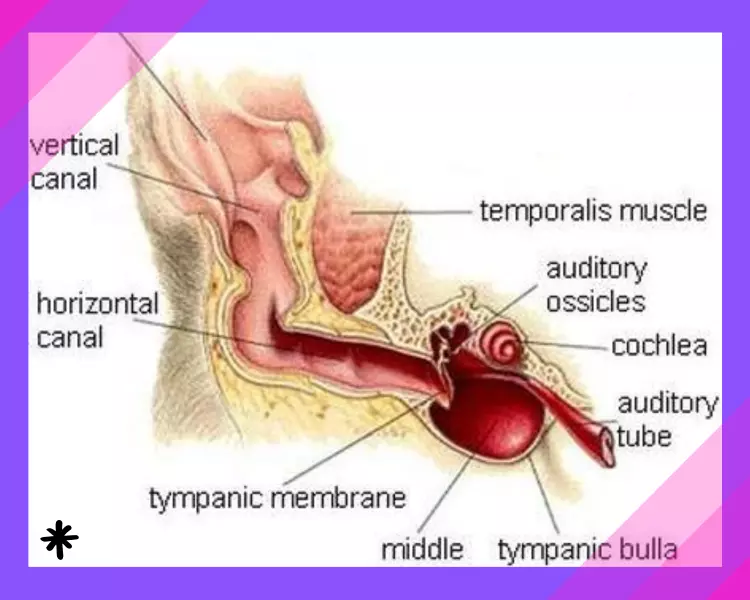In this article, we will delve into ‘How To Clean Your Dog’s Ears During Bath Time’. Maintaining your dog’s ear health not only enhances their quality of life but also helps prevent potential complications down the road. So, let’s dive in and learn the best practices for cleaning your dog’s ears during bath time, ensuring their comfort and well-being in the process.
Of all the body parts, the eyes, ears and nose are the most sensitive parts which require careful handling. So it is important to know how to clean your dog’s ears during bath time. Get ready to enhance your dog’s hygiene routine and keep their ears happy and healthy.
Understanding Your Dog’s Ear Structure: A Crucial Step Before Bathing
When it comes to bathing our beloved furry friends, it’s essential to pay attention to every detail, including the structure of their ears. Understanding your dog’s ear anatomy is a crucial step to ensure their bathing experience is safe, comfortable, and stress-free.
Dogs have a unique ear structure, with a delicate balance of sensitive tissues and canals. By familiarizing yourself with the intricacies of their ears, you can avoid potential complications, such as water entering the ear canal, which can lead to infections or discomfort.

From the above diagram, you can see that the canals are downward pointing. Its typically L shaped and it means that if any water goes inside, it will directly reach middle ear cavity. This middle ear cavity is directly connected to the auditory tube. This can cause serious problems. Therefore, it is important to prevent water from getting into the ears while bathing your dog.
My Personal Method Of Cleaning My Dogs Ears

It is always better to use a lump of cotton which not too small so as to get stuck in the ear canal. The Dog’s ear also has earwax which is a natural protection for the ear. So, it is best not to clean the ear until after the bath.
The only exception is if it is really dirty. You can clean it just until the visible parts, and then place the cotton in the dog’s ear. The remaining can be cleaned after the bath because the wax can protect the ears.
After i plug the ears with cotton, i just lace the outside of the area near the cotton, with just a drop of oil to repel the water. Just as a double protection. Remember, just a drop of oil.
After, the bath, i remove the cotton, and use a soft wet wipe to clean the dog’s ears thoroughly. Now let us look at the whole thing in detail.
How To Clean Your Dog’s Ears During Bath Time?
Use Cotton Balls

When it comes to protecting your dog’s ears during bath time, using cotton balls can be a helpful preventive measure. However, it’s crucial to understand the proper technique and ensure the cotton balls are the right size to avoid any potential complications.
Cotton balls can effectively act as a barrier, preventing water from entering your dog’s delicate ear canals. Before inserting them, make sure the cotton balls are large enough to cover the entrance of the ear canal adequately. This will help keep water out while allowing for proper airflow.
However, it’s important to be cautious and ensure that the cotton balls are not too small. Using overly small cotton balls can increase the risk of them getting stuck inside the ear canal, potentially causing discomfort or injury. To avoid this, gently insert the cotton balls into the outer part of the ear canal, being careful not to push them too far in.
While cotton balls can be beneficial, they are not a foolproof solution, especially for dogs with long or floppy ears that can easily trap water. It’s still essential to take other precautions, such as keeping water away from the ears as much as possible, using a gentle flow of water, and using a washcloth to clean the area around the ears.
Remember, you do get ear plugs too if you do not want to use cotton.
Use A Shower Cap

Water entering their ear canals can create a breeding ground for bacteria and yeast, leading to painful ear infections and discomfort. That’s where the shower cap comes in.
This ingenious accessory, often made from waterproof materials, acts as a barrier between your dog’s ears and the water, effectively preventing any unwanted moisture from entering.
Using a shower cap for your dog is relatively simple. Before bath time, gently place the cap over your dog’s ears, ensuring a snug fit that covers the entire ear area.
It’s important to note that not all dogs will be immediately comfortable with this new addition, so it’s essential to introduce the cap gradually, providing plenty of positive reinforcement and treats to associate it with a pleasant experience. Once the cap is secure, proceed with bathing your dog as usual, being careful which you must always.
Once you are done bathing the body, gently wash the face and you can slowly wash the area around the ears.
Mind The Water Direction

When it comes to bathing your dog, paying special attention to the sensitive area around their ears is crucial. To minimize the risk of water entering the ears and causing discomfort or potential complications, adopting a gentle approach is key.
While bathing your dog near the ears, it’s recommended to gently lift their face upward. This helps create a slight tilt, ensuring that water flows away from the ear canals instead of directly into them. By angling the head upward, you can help divert the water away from the sensitive ear area.
In addition to lifting the face, it’s important to slow down the flow of water during this process. Using a gentle stream or reducing the water pressure can help prevent water from forcefully entering the ears. Slowing down the flow gives you better control and minimizes the risk of water splashing into the ears.
Remember, directing the water backward is another effective technique. Instead of aiming the water directly onto the ears, try to aim it toward the back of the head and neck area. This way, any water that does come into contact with the ears will naturally flow away.
By following these gentle techniques and taking extra care while bathing near the ears, you can ensure a comfortable and safe experience for your dog. As always, consult with your veterinarian for specific guidance based on your dog’s needs and any concerns you may have.
Try Cleaning The Face With A Cloth
To provide an extra level of comfort and avoid the risk of water entering the ears, using a wet cloth can be a gentle and effective alternative.
Instead of direct water contact, opt for a soft, damp cloth to clean the area around your dog’s ears during bath time. Gently wipe the outer part of the ears, removing any dirt or debris. This method allows you to effectively clean the ears without the worry of water entering the ear canals.
Using a wet cloth has several advantages when bathing near the ears. It gives you more control and precision, allowing you to focus on specific areas without the risk of excessive moisture. Additionally, it can be a soothing and relaxing experience for your dog, as the soft cloth provides a gentle touch.
Remember to be gentle while using the wet cloth and avoid applying excessive pressure to the ears. Take your time and ensure thorough yet gentle cleaning, paying attention to folds or creases where dirt or moisture may accumulate.
By utilizing a wet cloth as an alternative to water, you can maintain the cleanliness of your dog’s ears while minimising the risk of discomfort or potential complications.
If Your Dog Has A Ear Infection
If your beloved canine companion is showing signs of an ear infection, it’s essential to address the issue promptly and seek professional guidance. While it can be tempting to try home remedies or over-the-counter solutions, it’s crucial to understand that treating an ear infection requires a medically prescribed solution.
Consulting your trusted veterinarian is vital in determining the best course of action for your dog’s specific condition. They will examine your furry friend’s ears, diagnose the infection, and prescribe the appropriate medication for effective treatment.
Additionally, it’s important to consult your vet before bathing your dog during this time, as water exposure may exacerbate the infection or interfere with the prescribed treatment. Prioritizing your dog’s health and seeking expert advice will help ensure their comfort and recovery from an ear infection.
Use An Ear Cleaning Solution
After giving your furry friend a refreshing bath, it’s a good idea to follow up with a gentle ear cleaning to maintain their overall hygiene. Using an appropriate ear cleaning solution specifically designed for dogs can help keep their ears clean and prevent potential infections.
These solutions are formulated to effectively remove dirt, debris, and excess wax without irritating the delicate ear canal. Begin by applying a few drops of the solution into your dog’s ear, gently massaging the base of the ear to distribute the liquid.
You can then use a clean cotton ball or soft cloth to carefully wipe away any loosened debris from the outer part of the ear. Remember to avoid inserting anything into the ear canal to prevent injury. Regular ear cleaning, after bathing or as advised by your veterinarian, can contribute to your dog’s ear health and well-being.
Do Not Use Q Tips / Buds
When it comes to cleaning your dog’s ears after a bath, it’s crucial to remember one golden rule: never use Q-tips or earbuds. While these tools may seem harmless or convenient, they can actually pose serious risks to your furry friend’s ear health.
The shape and size of a dog’s ear canal differ from ours, making it much more sensitive and prone to damage. Inserting a Q-tip or earbud into their ear canal can lead to injuries, such as scratches or punctures, and may even push debris further inside, causing blockages or infections.
Instead, opt for safer alternatives recommended by veterinarians, such as using a dog-specific ear cleaning solution and a soft cloth or cotton ball to gently clean the outer part of the ear. Remember, prioritizing your dog’s well-being means steering clear of any potentially harmful practices and seeking professional guidance when needed.
Veterinary Dermatology – A Few Research Papers
Over Cleaning The Ear Is Also Dangerous
This article emphasizes the importance of ear cleaning for maintaining a healthy ear environment and treating otitis. While manual cleaning is suitable for regular cleansing, it may not remove stubborn debris. It explains why regular veterinary visits are important. – Ear cleaning: the UK and US perspective – Nuttall – 2004 – Veterinary Dermatology – Wiley Online Library.
Ear Cleaning Need Not Be Performed In Healthy Dogs
Ear cleaning does not routinely need to be performed in clean, healthy ears; however, it can be an essential part of the treatment regimen in otitis externa. (an ear disease) – vancouver-otitis-handout.pdf (canadianveterinarians.net). So, in my view, Check your dogs ears and ensure that there is no discharge or dirt. If you see that the ears are clean, do not force clean by going deeper in.
Summary:
In conclusion, bathing your dog is an important aspect of their overall hygiene and well-being. However, it’s crucial to exercise caution and take extra care when it comes to their ears. Remember, dogs’ ears are sensitive and prone to infections, so it’s vital to prevent water from entering their ear canals during bath time.
Excessive moisture in the ears can create a breeding ground for bacteria and increase the risk of painful ear infections. To protect your furry friend’s ears, consider using cotton balls or specially designed ear covers to prevent water from entering the ear canals.
Additionally, after bath time, it’s advisable to use a dog-specific ear cleaning solution to gently clean the outer part of the ears, without inserting anything into the ear canal. By following these simple precautions, you can ensure that your dog stays clean, comfortable, and free from the discomfort of ear-related issues.
Water In Dogs Ears During Bath

It’s important to be mindful of water entering your dog’s ears while giving them a bath. Dogs’ ears are delicate and susceptible to moisture-related issues.
Allowing water to enter their ear canals can create a favorable environment for bacteria and yeast to thrive, potentially leading to painful ear infections.
To prevent this, take extra precautions during bath time. Avoid directing the water stream directly into their ears and be cautious around the head and neck area.
Placing cotton balls or specially designed ear covers can act as a barrier, preventing water from entering the ear canals. Remember, a little bit of prevention goes a long way in safeguarding your furry friend’s ear health and overall well-being.
Clean Dog Ears Before Or After Bath

Cleaning your dog’s ears after a bath can indeed be beneficial, as it helps maintain their ear health. One interesting advantage is that the natural wax produced by your dog’s ears has an oily texture that can act as a protective barrier.
This wax helps prevent excessive water from entering the ear canal during bathing. However, it’s important to note that this does not eliminate the need for ear cleaning altogether.
Regular ear cleaning with a dog-specific ear cleaning solution helps remove any excess wax, dirt, or debris that may have accumulated. This ensures proper hygiene and reduces the risk of potential ear infections.
By cleaning your dog’s ears after a bath, you strike a balance between preserving the protective qualities of their natural wax and maintaining optimal ear cleanliness.
How To Dry Dogs Ears After Bath

Drying your dog’s ears properly after a bath is essential to prevent moisture-related issues and promote ear health. Begin by gently drying the outer part of their ears using a clean towel. Make sure to be gentle and avoid rubbing vigorously, as it may cause irritation.
Next, you can use a soft, absorbent cloth or cotton ball to carefully dab the inside of the ear, focusing on the visible areas and avoiding the ear canal. It’s important not to insert anything into the ear canal to avoid potential injury.
If your dog has long or floppy ears, you may also consider using a pet-safe ear drying solution recommended by your veterinarian. This solution can help evaporate any residual moisture and prevent the buildup of moisture in the ear canal.
Remember, taking the time to properly dry your dog’s ears after a bath contributes to their overall comfort and helps maintain optimal ear hygiene.
How To Treat Dog Ear Infection Without Vet

When it comes to treating a dog’s ear infection, it’s crucial to prioritize veterinary consultation and guidance. Attempting to address an ear infection without professional advice can be risky and may not effectively resolve the underlying issue.
Keep in mind that you may not know if your dog requires internal medication along with regular cleaning to combat the infection. Only a qualified veterinarian can properly diagnose the type and severity of the ear infection and prescribe the appropriate treatment plan.
Additionally, it’s important to emphasize the significance of regular ear cleaning in preventing ear infections. By maintaining a consistent ear cleaning routine, you can help remove excess wax, dirt, and debris, reducing the chances of infection.
Remember, when it comes to your dog’s ear health, consult your veterinarian for proper diagnosis, treatment, and preventive care.
